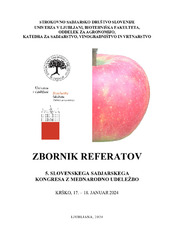Приказ основних података о документу
HOW DOES SECTORIAL PRUNING AFFECT THE VEGETATIVE GROWTH, PRODUCTIVITY AND FRUIT QUALITY OF SUBSTRATE-GROWN HIGHBUSH BLUEBERRY CV. 'BLUECROP'?
| dc.creator | Milivojević, Jasminka M | |
| dc.creator | Radivojević, Dragan | |
| dc.creator | Boskov, Djordje | |
| dc.creator | Dragišić Maksimović, Jelena | |
| dc.creator | Milosavljević, Dragica | |
| dc.creator | Spasojević, Slavica | |
| dc.creator | Veberič, Robert | |
| dc.creator | Mikulič Petkovšek, Maja | |
| dc.date.accessioned | 2024-01-25T08:47:11Z | |
| dc.date.available | 2024-01-25T08:47:11Z | |
| dc.date.issued | 2024 | |
| dc.identifier.isbn | 978-961-91301-6-2 | |
| dc.identifier.uri | http://rimsi.imsi.bg.ac.rs/handle/123456789/3178 | |
| dc.description.abstract | The impact of pruning techniques on the plant growth, yield components and fruit quality traits of substrate-grown highbush blueberry (Vaccinium corymbosum) cultivar 'Bluecrop' were evaluated over four years (2019-2022). The orchard was planted in the village of Gruža (Knić municipality, Serbia) in the spring of 2017 with 5-year-old nursery plants using 113 l polypropylene pots spaced 0.8 m apart in a row and 3.0 m between rows (4,170 plants/ha). At the onset of the trial the ‘Bluecrop’ plants were 8 years old. The two pruning techniques were applied: i) conventional pruning (CP) - removal of the most unproductive canes at the center of the canopy, and weak and excessively fruiting shoots from the top of bushes, and ii) sectorial pruning (SP) - only removal of basal canes in ¼ of the canopy each year. The average number of basal canes per bush was significantly lower in SP than in the CP treatment (14.4 vs. 17.4 canes bush-1 , respectively). SP plants had thinner canes than CP plants, which increased over the years of the study and reached a maximum diameter of 11.12 mm in 2022. CP had a positive influence on fruit yield (5.98 kg bush-1 ), which was associated with a 20% higher number of fruits per bush than in sectorial pruned plants. The fruit yield increased in the first three years of the study, reaching a maximum value in 2021 (7.57 kg per bush), whereas an opposite trend was observed in average fruit weight over the years, with the lowest value reached in the last harvest year (1.81 g). Fruit weight and soluble solids content were not affected by the pruning method, while the content of total acids, total anthocyanins and total phenolics were significantly higher in fruit harvested from the SP treatment (0.70%, 37.04 mg eq mvd-3-G /100 g FW and 1.18 mg eq GA/g FW, respectively) along with the total antioxidant capacity (8.39 mg eq AsA /g FW). | sr |
| dc.language.iso | en | sr |
| dc.publisher | Strokovno sadjarsko društvo Slovenije, Jamnikarjeva 101, SI-1000 Ljubljana | sr |
| dc.relation | info:eu-repo/grantAgreement/MESTD/inst-2020/200116/RS// | sr |
| dc.relation | info:eu-repo/grantAgreement/MESTD/inst-2020/200053/RS// | sr |
| dc.rights | openAccess | sr |
| dc.source | 5. SLOVENSKEGA SADJARSKEGA KONGRESA Z MEDNARODNO UDELEŽBO | sr |
| dc.subject | highbush blueberry | sr |
| dc.subject | substrate cultivation | sr |
| dc.subject | pruning | sr |
| dc.subject | plant growth | sr |
| dc.subject | yield | sr |
| dc.subject | fruit quality traits | sr |
| dc.title | HOW DOES SECTORIAL PRUNING AFFECT THE VEGETATIVE GROWTH, PRODUCTIVITY AND FRUIT QUALITY OF SUBSTRATE-GROWN HIGHBUSH BLUEBERRY CV. 'BLUECROP'? | sr |
| dc.type | conferenceObject | sr |
| dc.rights.license | ARR | sr |
| dc.citation.spage | 9 | |
| dc.identifier.fulltext | http://rimsi.imsi.bg.ac.rs/bitstream/id/8427/bitstream_8427.pdf | |
| dc.identifier.rcub | https://hdl.handle.net/21.15107/rcub_rimsi_3178 | |
| dc.type.version | publishedVersion | sr |

